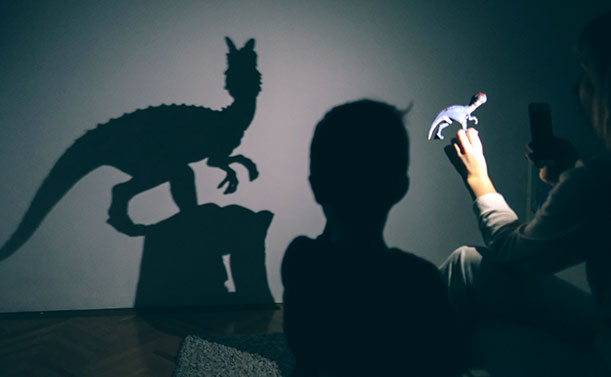BOOMbox at Home: Myths
July 30, 2020

Sharing stories is a great way to pass the time, express creativity, and learn a lesson or two. The Crash Course YouTube series provides definitions and historical context for interpretations of myths. The two activities below invite you to explore storytelling related to myths.
Shadow Puppets
Shadow puppets, like the ones in this 3 Little Piggies puppet show, can be used to convey myths or stories. Shadow puppets originated in Central Asia, possibly in India or China, around the first millennia BCE. It is said that shadow puppets came about when the Wu Emperor lost his beloved wife. His minister was trying to come up with a way of making the Emperor happy again when he saw children playing with shadows. Using the inspiration of the children playing, the minister created shadow puppets. The minister cut out a puppet of his wife and played it for the Emperor, who loved it.
Knowing the origins of shadow puppets, create your own puppets to tell your story. To help come up with a story, think about myths you heard shared by family, or myths or stories that shaped how you see the world. How would you tell your own myth? Who would your audience be?
Need inspiration? A staff member recently used shadow puppets to tell a story about fish during a camping trip. You can follow an online tutorial to build your own shadow puppet theater with a cardboard box, tissue paper, and some tape.
Narrative Theory
Consider for a moment your favorite movie, short story, or novel. What are some of the elements that made it so memorable? Was it the setting or the characters? Perhaps it is the structure of the story itself.
Watch a video about narrative story structure to gain an understanding of the theory behind effective storytelling. Return to your favorite piece of narrative media, like your favorite book or movie you have enjoyed over and over again, and try to identify the stages outlined in the video. Which stages were obvious? Which stages were more challenging to identify?
Using your new understanding of narrative theory, consider creating your own story. Will you write a book, or a screenplay?
Activist of the Week
Hoskie Benally is a Dine (Navajo) who lives in Shiprock, New Mexico. At age 22, Hoskie went blind due to retinitis pigmentosa. He was offered a job a year later at a youth treatment center at Our Youth, Our Future. Hoskie created a treatment program that was a blend of western treatment programs and Native American teachings. These teachings would be the core of the program, as Hoskie believes a strong sense of identity and a cultural foundation were vital for healing. Storytelling of Native teachings is a cultural ritual to connect with their heritage and spiritual roots.
Share
We’d love to see the results of your experiments! Tag @skokielibrary when you share photos of what you’ve created on social media.
Written by Erica and Ladipo.